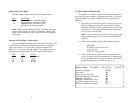
3
1.3 RADIO AND TV INTERFERENCE
The NetLink-T1™ Model 2710 Series generates and uses radio
frequency energy, and if not installed and used properly—that is, in
strict accordance with the manufacturer's instructions—may cause
interference to radio and television reception. The Model 2710 Series
has been tested and found to comply with the limits for a Class A
computing device in accordance with the specifications in Subpart J of
Part 15 of FCC rules, which are designed to provide reasonable pro-
tection from such interference in a commercial installation. However,
there is no guarantee that interference will not occur in a particular
installation. If the Model 2710 Series does cause interference to radio
or television reception, which can be determined by disconnecting the
cables, the user is encouraged to try to correct the interference by one
or more of the following measures: moving the computing equipment
away from the receiver, re-orienting the receiving antenna, and/or
plugging the receiving equipment into a different AC outlet (such that
the computing equipment and receiver are on different branches).
1.4 FCC INFORMATION
The Model 2710 Series has been tested and registered in com-
pliance with the specifications in Part 68 of the FCC rules. A label on
the equipment bears the FCC registration number. You may be
requested to provide this information to your telephone company.
Your telephone company may make changes in its facilities,
equipment, operations or procedures that could affect the proper oper-
ation of the Model 2710 Series. If this happens, the telephone com-
pany should give you advance notice to prevent the interruption of
your service.
The telephone company may decide to temporarily discontinue
your service if they believe your Model 2710 Series may cause harm
to the telephone network. Whenever possible, they will contact you in
advance. If you elect to do so, you have the right to file a complaint
with the FCC.
If you have any trouble operating the Model 2710 Series, please
contact Patton Technical Support at (301) 975-1007. The telephone
company may ask you to disconnect the equipment from the tele-
phone network until the problem has been corrected or until you are
certain that the Model 2710 Series is not malfunctioning.
The following information may be required when applying to your
local telephone company for leased line facilities:
Facility
Interface Service Network
Service Code Code Connection
1.544 Mbps SF format without line power 04DU9-BN 6.0N RJ48C
1.544 Mbps SF and B8ZS without line power 04DU9-DN 6.0N RJ48C
1.544 Mbps ANSI ESF without line power 04DU9-1KN 6.0N RJ48C
1.544 Mbps ANSI ESF and B8ZS w/o line power 04DU9-1SN 6.0N RJ48C
4
1.4.1 FCC Compliance:
The Model 2710 has been tested and found to comply with the
specifications found in Part 68 of the FCC rules and regulations. A
label on the equipment bears the FCC registration number. You may
be requested to provide this information to your telephone company.
The telephone company may decide to temporarily discontinue
your service if they believe that the Model 2710 may cause harm to the
telephone network. Whenever possible the telephone company will
attempt to notify you in advance. You have a right, if you so choose, to
file a complaint with the FCC.
In accordance with FCC rules and regulation CFR 47 68.218(b)(6),
the user must notify the telephone company prior to disconnection.
The Universal Service Order Code (USOC) is RJ48.
The Facility Interface Codes (FIC) are 04DU9-BN, 04DU9-DN, 04DU9-
1KN, and 04DU9-1SN.
The Service Order Code (SOC) is 6.0N
1.5 INDUSTRY CANADA NOTICE :
The Canadian Department of Communications label identifies cer-
tified equipment. This certification means that the equipment meets
certain telecommunications network protective, operational and safety
requirements. The Department does not guarantee the equipment will
operate to the user's satisfaction.
Before installing this equipment, users should ensure that it is per-
missible to be connected to the facilities of the local telecommunica-
tions company. The equipment must also be installed using an accept-
able method of connection. In some cases, the company’s inside
wiring associated with a single line individual service may be extended
by means of a certified connector assembly (telephone extension
cord). The customer should be aware that compliance with the above
condition may not prevent degradation of service in some situations.
Repairs to some certified equipment should be made by an
authorized maintenance facility designated by the supplier. Any repairs
or alterations made by the user to this equipment, or equipment mal-
functions, may give the telecommunications company cause to request
the user to disconnect the equipment.
Users should ensure for their own protection that the ground con-
nections of the power utility, telephone lines and internal metallic
water pipe system, are connected together. This protection may be
particularly important in rural areas.
CAUTION: Users should not attempt to make such connections
themselves, but should contact the appropriate electric inspection
authority, or electrician, as appropriate.


















